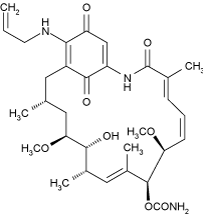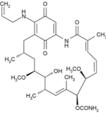Replaces Prod. #: ALX-380-091
17-AAG is a less toxic and more stable analog of geldanamycin. It is an HSP90 inhibitor that displays a 100-fold higher affinity for HSP90 derived from tumor cells compared to HSP90 from normal cells. 17-AAG inhibits Akt activation and expression in tumors and synergizes with a number of antitumor agents such as taxol, cisplatin, and UCN-014. 17-AAG causes the inactivation, destabilization and eventual degradation of HIF-1α. Inhibitor of telomerase activity. Inducer of apoptosis with antitumor activity. Inducer of macroautophagy.
Product Details
| Alternative Name: | 17-(Allylamino)-17-desmethoxygeldanamycin |
| |
| Formula: | C31H43N3O8 |
| |
| MW: | 585.7 |
| |
| Source: | Semisynthetic derivative from geldanamycin. |
| |
| CAS: | 75747-14-7 |
| |
| Purity: | ≥98% (TLC) |
| |
| Identity: | Determined by 1H-NMR. |
| |
| Appearance: | Red to dark red or purple solid. |
| |
| Solubility: | Soluble in DMSO (>20mg/ml) or 100% ethanol (10mg/ml). |
| |
| Shipping: | Ambient Temperature |
| |
| Long Term Storage: | -20°C |
| |
| Handling: | Protect from light. |
| |
| Technical Info/Product Notes: | Replacement for ADI-HPK-101. |
| |
| Regulatory Status: | RUO - Research Use Only |
| |
Please mouse over
Product Literature References
Hsp90‐mediated regulation of DYRK3 couples stress granule disassembly and growth via mTORC1 signaling: L. Mediani, et al.; EMBO Rep.
2021, e51740 (2021),
Abstract;
Radicicol induces intracellular accumulation of glycan-deficient clusterin variant: I. Choi, et al.; Biochem. Biophys. Res. Commun.
458, 555 (2015),
Application(s): Cell Culture,
Abstract;
Reversing drug resistance of cisplatin by hsp90 inhibitors in human ovarian cancer cells: Z. Zhang, et al.; Int. J. Clin. Exp. Med.
8, 6687 (2015),
Application(s): Cell Culture,
Abstract;
Full Text
Sensitization of Chemo-Resistant Human Chronic Myeloid Leukemia Stem-Like Cells to Hsp90 Inhibitor by SIRT1 Inhibition: H.B. Kim, et al.; Int. J. Biol. Sci.
11, 923 (2015),
Application(s): Cell Culture,
Abstract;
Full Text
Aryl hydrocarbon receptor is a target of 17-Allylamino-17-demethoxygeldanamycin and enhances its anticancer activity in lung adenocarcinoma cells: P.H. Chen, et al.; Mol. Pharmacol.
83, 605 (2013),
Abstract;
Full Text
17-AAG induces cytoplasmic alpha-synuclein aggregate clearance by induction of autophagy: M. Riedel, et al.; PLos One
5, e8753 (2010),
Abstract;
Full Text
An in vitro and in vivo study of the combination of the heat shock protein inhibitor 17-allylamino-17-demethoxygeldanamycin and carboplatin in human ovarian cancer models: U. Banerji, et al.; Cancer Chemother. Pharmacol.
62, 769 (2008),
Abstract;
HSP90 inhibitor 17AAG causes apoptosis in ATRA-resistant acute promyelocytic leukemia cells: P.N. Meyer, et al.; Leuk. Res.
32, 143 (2008),
Abstract;
Drugging the cancer chaperone HSP90: Combinatorial therapeutic exploitation of oncogene addiction and tumor stress: P. Workman, et al.; Ann. N.Y. Acad. Sci.
1113, 202 (2007),
Abstract;
Intratumor injection of the Hsp90 inhibitor 17AAG decreases tumor growth and induces apoptosis in a prostate cancer xenograft model: C.R. Williams, et al.; J. Urol.
178, 1528 (2007),
Abstract;
Phase I and pharmacodynamic study of 17-(allylamino)-17-demethoxygeldanamycin in adult patients with refractory advanced cancers: R.K. Ramanathan, et al.; Clin. Cancer Res.
13, 1769 (2007),
Abstract;
Rituximab and 17-allylamino-17-demethoxygeldanamycin induce synergistic apoptosis in B-cell chronic lymphocytic leukaemia: A.J. Johnson, et al.; Br. J. Haematol.
139, 837 (2007),
Abstract;
Synergism between etoposide and 17-AAG in leukemia cells: critical roles for Hsp90, FLT3, topoisomerase II, Chk1, and Rad51: Q. Yao, et al.; Clin. Cancer Res.
13, 1591 (2007),
Abstract;
Full Text
Chaperoning oncogenes: HSP90 as a target of geldanamycin: L. Neckers; Handb. Exp. Pharmacol.
172, 259 (2006), (Review),
Abstract;
Quantitative effects on c-Jun N-terminal protein kinase signaling determine synergistic interaction of cisplatin and 17-allylamino-17-demethoxygeldanamycin in colon cancer cell lines: I.A. Vasilevskaya, et al.; Mol. Pharmacol.
65, 235 (2004),
Abstract;
A high-affinity conformation of Hsp90 confers tumour selectivity on Hsp90 inhibitors: A. Kamal, et al.; Nature
425, 407 (2003),
Abstract;
ErbB2 degradation mediated by the co-chaperone protein CHIP: P. Zhou, et al.; J. Biol. Chem.
278, 13829 (2003),
Abstract;
Geldanamycin and its 17-allylamino-17-demethoxy analogue antagonize the action of Cisplatin in human colon adenocarcinoma cells: differential caspase activation as a basis for interaction: I.A. Vasilevskaya, et al.; Cancer Res.
63, 3241 (2003),
Abstract;
Inhibition of heat shock protein 90 function down-regulates Akt kinase and sensitizes tumors to Taxol: D.B. Solit, et al.; Cancer Res.
63, 2139 (2003),
Abstract;
Inhibition of telomerase activity by geldanamycin and 17-allylamino, 17-demethoxygeldanamycin in human melanoma cells: R. Villa, et al.; Carcinogenesis
24, 851 (2003),
Abstract;
Synergistic antileukemic interactions between 17-AAG and UCN-01 involve interruption of RAF/MEK- and AKT-related pathways: W. Jia, et al.; Blood
102, 1824 (2003),
Abstract;
Disruption of the EF-2 kinase/Hsp90 protein complex: a possible mechanism to inhibit glioblastoma by geldanamycin: J. Yang, et al.; Cancer Res.
61, 4010 (2001),
Abstract;
Full Text
Enhancement of paclitaxel-mediated cytotoxicity in lung cancer cells by 17-allylamino geldanamycin: in vitro and in vivo analysis: D.M. Nguyen, et al.; Ann. Thorac. Surg.
72, 371 (2001),
Abstract;
Geldanamycin and its analogue 17-allylamino-17-demethoxygeldanamycin lowers Bcr-Abl levels and induces apoptosis and differentiation of Bcr-Abl-positive human leukemic blasts: R. Nimmanapalli, et al.; Cancer Res.
61, 1799 (2001),
Abstract;
Full Text
Inhibition of heat shock protein 90 function by ansamycins causes the morphological and functional differentiation of breast cancer cells: P.N. Munster, et al.; Cancer Res.
61, 2945 (2001),
Abstract;
Full Text
Gene expression profiling of human colon cancer cells following inhibition of signal transduction by 17-allylamino-17-demethoxygeldanamycin, an inhibitor of the hsp90 molecular chaperone: P.A. Clarke, et al.; Oncogene
19, 4125 (2000),
Abstract;
The benzoquinone ansamycin 17-allylamino-17-demethoxygeldanamycin binds to HSP90 and shares important biologic activities with geldanamycin: T.W. Schulte & L.M. Neckers; Cancer Chemother. Pharmacol.
42, 273 (1998),
Abstract;
Inhibition of the oncogene product p185erbB-2 in vitro and in vivo by geldanamycin and dihydrogeldanamycin derivatives: R.C. Schnur, et al.; J. Med. Chem.
38, 3806 (1995),
Abstract;













